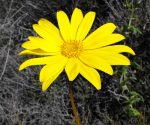 Also known as beach coreopsis, this herbaceous perennial is a member of the aster family, Asteraceeae, that also includes daisy, sunflower, and lettuce. It is native to coastal areas of Southern California and Baja California where it grows on bluffs and dunes. Plants grow 1-3′ tall from a fleshy taproot and have many branching stems. The yellow green leaves are bipinanate with linear segments, slightly succulent ,and up to 6″ long. One to two flower heads per stem appear from late winter to early summer on long peduncles. Each flower head is 2.5-4″ across and consists of 16-21 yellow ray flowers surrounding a center of yellow disc flowers. Sea dahlia is often grown as an annual, needs very well drained soil, and is best used in a naturalized setting. Flowers are excellent for the vase. The genus name, Coreopsis, comes from the Greek words koris meaning bug and opsis meaning like/similar to and refers to the appearance of the seed. The specific epithet, maritima, comes from the Latin word maritimus meaning pertaining to the sea and refers to the natural habitat of the plant.
Also known as beach coreopsis, this herbaceous perennial is a member of the aster family, Asteraceeae, that also includes daisy, sunflower, and lettuce. It is native to coastal areas of Southern California and Baja California where it grows on bluffs and dunes. Plants grow 1-3′ tall from a fleshy taproot and have many branching stems. The yellow green leaves are bipinanate with linear segments, slightly succulent ,and up to 6″ long. One to two flower heads per stem appear from late winter to early summer on long peduncles. Each flower head is 2.5-4″ across and consists of 16-21 yellow ray flowers surrounding a center of yellow disc flowers. Sea dahlia is often grown as an annual, needs very well drained soil, and is best used in a naturalized setting. Flowers are excellent for the vase. The genus name, Coreopsis, comes from the Greek words koris meaning bug and opsis meaning like/similar to and refers to the appearance of the seed. The specific epithet, maritima, comes from the Latin word maritimus meaning pertaining to the sea and refers to the natural habitat of the plant.
Type: Herbaceous perennial
Bloom: Flower heads 2.5-4″ across with 16-21 yellow ray flowers surrounding yellow disc flowers; from late winter to early summer
Size: 1-3′ H x 1-2′ W
Light: Full sun
Soil: Lean, dry, very well-drained
Hardiness: Zones 9-10
Care: Low maintenance
Pests and Diseases: None of significance
Propagation: Seed
Companion Plants: Sea fiddleneck (Amsinckia spectabilis), sea cliff daisy (Malacothrix saxatilis), red Sand verbena (Abronia maritima), beach morning glory (Calystegia soldanella)
Photo Credit: Stickpen ,Wikimedia Commons